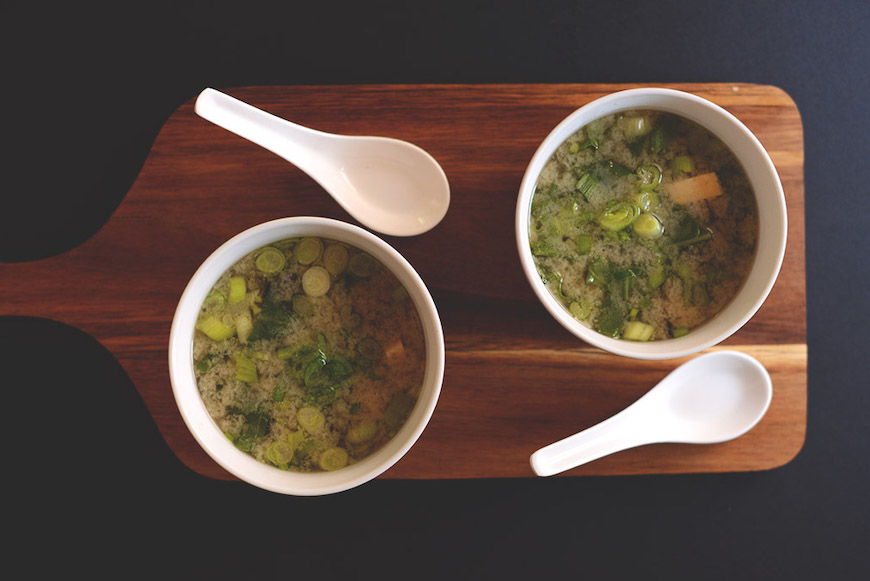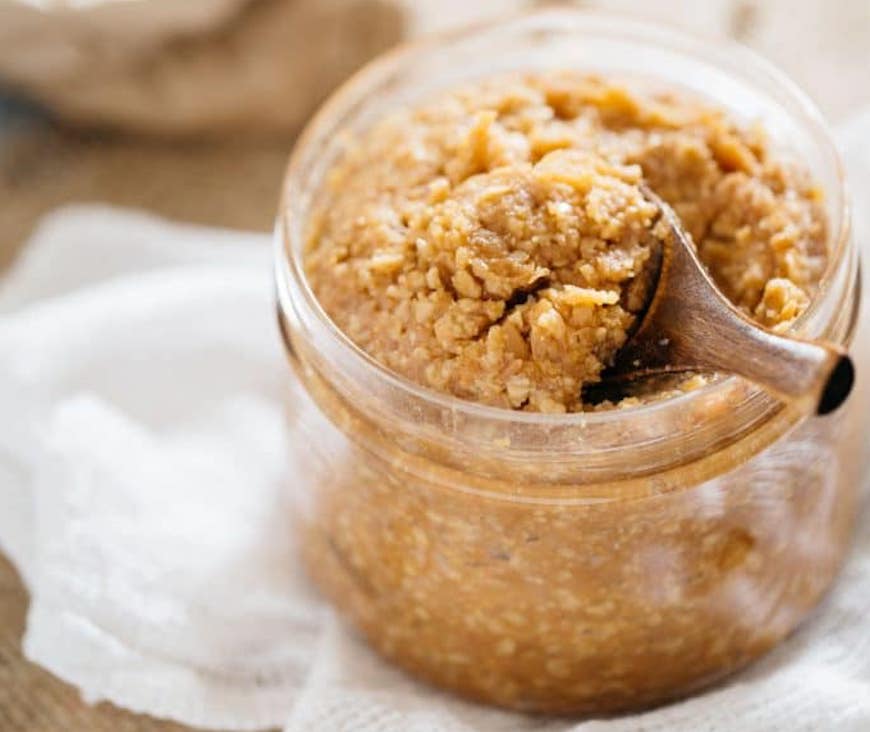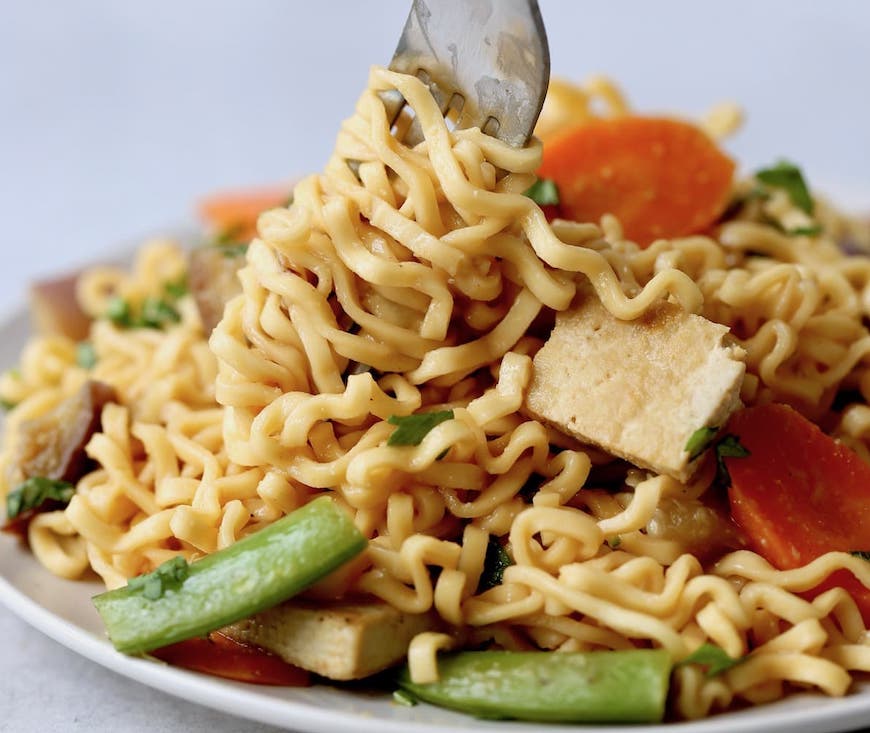5 Miso Health Benefits for Gut Health, Energy, and More
Aside from making a tasty soup, miso (on its own) is so rich in flavor and health benefits—plus is incredibly versatile and easy to use—that it's well-worth adding the ingredient into other parts of your diet, pronto. Ahead we're diving into the benefits of miso, and tons of ways to use it (aside from making soup).
What is miso?
The word miso translates to "fermented beans" in Japanese, which is what miso is made from: fermented soybeans and grains, which can then be used in everything from veggie dishes, marinades, dressings, glazes, and, yes, soups. Miso reportedly originated from China and was introduced to Japan over 1,300 years ago.
- Erica Ingraham, MS, RDN, nutritionist, registered dietitian, and the founder of Listen Nutrition
At the time, it was used to help preserve food, but its rich umami flavor—a balance of salty, earthy, and a tiny bit sweet—was so good that it quickly started being used as an ingredient in its own right. Although miso was once a highly sought-after precious commodity, nowadays it's widely available, easy to find, and rather affordable (costs roughly $8 per 13-ounce container). Not to mention, a little goes a long way.
Here, registered dietitian Erica Ingraham, RD, shares the complete lowdown on miso health benefits. Plus, get ideas for how to cook with miso at home.
Miso health benefits every healthy eater should know
1. It's rich in gut-healthy probiotics
The fact that miso is a fermented food probably tipped you off to this one: it's one of the tastiest fermented foods for gut health. "One reason fermented foods like miso benefit the gut because is because they contain probiotics," Ingraham says. "Probiotics are helpful live bacteria that are associated with a range of health benefits including reduced inflammation, healthy digestion, and supporting healthy immune system function," she says.

{{post.sponsorText}}
While experts generally caution that probiotics and fermented foods alone likely don't have a huge impact on gut health (and there isn't a ton of research specifically linking miso consumption to improved gut health) incorporating foods with miso into a healthy diet filled with other gut-friendly foods (like fiber and plants) can certainly help set the foundation for a robust microbiome. That said, keep in mind that if you have any predispositions to GI-related or digestion irregularities, it may be best to avoid eating fermented foods on an empty stomach.
2. It contains a wide array of vitamins that support the nervous system
High in vitamins? Check. "Miso contains a range of B vitamins including vitamin B1 (thiamin), B2 (riboflavin), B3 (niacin), B5 (pantothenic acid), and B9 (folate)," Ingraham says, adding that each one benefits the body in different ways. She says that B3, B5, and B9 help support the nervous system. Considering that the nervous system controls movement and balance, all five senses, and thought processing in the brain, it's majorly important to get enough of these essential vitamins.
B vitamins also help provide the body with energy—in other words, without enough of the nutrient in your diet, you may experience sluggishness. "B vitamins are essential for energy production and are involved in reactions of breaking down food into a usable form of energy for the body," Ingraham says. Yet another reason to load up on miso and other foods high in B vitamins.
Keep in mind, replenishing B vitamins is important, as they don't remain in the body for very long. "B vitamins are water soluble, meaning they are not stored within the body like fat soluble vitamins are," Ingraham adds. "As such, it is important to get adequate intake of all essential B vitamins since they are not stored within the body."
3. It can help support a healthy pregnancy
Ingraham says that miso's vitamin B9, aka folate, can especially benefit women in early pregnancy. "[Folate is] important for preventing certain birth defects that affect spinal cord development, known as spina bifida," she says. That said, it's always important to consult with a healthcare professional before introducing something new to your daily routine to ensure it's right for you.
4. It's good for your bones
Another nutrient miso is rich in is vitamin K, with 29 microunits per 100 grams (it's recommended to get 90 micrograms a day). "Vitamin K is a fat-soluble vitamin that plays an important role in blood clotting, which is important for healing wounds and cuts, and bone health," Ingraham says. Not getting enough vitamin K could lead to developing osteoporosis, which becomes even more prevalent as you age.
5. It might be beneficial for cardiovascular health
One animal study found that consuming miso regularly may help protect against strokes. The caveat to this is that it must be done in conjunction with sticking to a low-salt diet. Another small study of Japanese adults found that regular miso soup consumption was associated with decreased heart rate (but had no clear effects on blood pressure). While more research needs to be done—including larger studies with human participants—it's possible that consuming miso regularly could benefit the cardiovascular system.
Is miso safe for everyone?
It's clear that miso is loaded with health benefits for the entire body. But if you have a soy allergy, steer clear, as miso is made from fermented soy. It's also good to be mindful of your overall salt intake when eating miso, as it can be high in sodium. (For context, just one tablespoon has over 600 milligrams, which is 26 percent of your daily maximum recommended intake of sodium.) That said, sodium content can vary from brand to brand, and most miso recipes call for only a small amount of the ingredient.
What to know when buying miso
These days, miso can be found at many grocery stores in the refrigerated section, or at specialty markets. You'll notice that there might be multiple different kinds displayed on the shelves—which have slightly different flavor profiles and uses.
"The darker misos—dark red, brown, barley misos—are fermented longer than the light-colored ones," Ingraham says. In general, the darker the color, the more intense the flavor. "The lighter ones, like white and yellow misos, may be better for dressings, glazes, and light sauces, while the darker misos are good for heartier dishes like stews and heavier soups."
Not sure how to cook with miso at home? Keep reading for some ideas.
6 delicious miso recipes to make at home

1. 15-Minute Miso Soup
So, is miso soup healthy? Signs point to a definitive yes (so long as it's consumed in moderation). In fact, did you know that miso soup is a healthy part of many Japanese breakfast recipes that some of the longest-living people in the world eat nearly every day?
Indeed, soup is one of the most popular ways to consume miso and in case you haven't cooked with miso before, this recipe by Minimalist Baker is a great place to start. Besides miso paste, this simple recipe is packed with green veggies and protein-rich tofu, making it well-rounded enough to be the main course for dinner—not just an appetizer. Of course, this is just one of the many miso recipes we love. In fact, you can also make a hormone-balancing miso soup with the help of the right ingredients.
Get the recipe: 15-Minute Miso Soup

2. Miso Paste
Make your own miso paste to have on hand by following this simple three-ingredient recipe by Chopstick Chronicles—it's easier than you may think! All you need are dried soybeans, koji (a fermented rice-derived product which can be found in Japanese stores or online), salt, and water. The trick is mastering the technique and letting fermentation do the rest of the work. With a little patience, you'll be on your way to noshing on homemade miso in no time.
Get the recipe: Miso Paste

3. Miso Fried Rice
Adding miso to your fried rice is an easy way to add in more complex flavors (hi, umami) to your dish. Feel free to add tofu or chicken to up the protein content in this recipe by A Family Feast, and substitute any fiber-rich veggies you have on hand to make it even healthier and more delicious.
Get the recipe: Miso Fried Rice

4. Miso Roasted Cauliflower
On its own, cauliflower can taste, well, pretty bland. But that's exactly what makes it such an amazing healthy food chameleon. This easy recipe by Plants and Pairings shows how to roast cauliflower with miso paste and red pepper flakes, making it a delicious savory side dish with a bit of a kick. Top it with cilantro and lime juice to add another zesty layer to the already rich flavor profile.
Get the recipe: Miso Roasted Cauliflower

5. Miso-Flavored Noodles
Ramen lovers, this one's for you. Slurping up the noodles in this dish by The Conscientious Eater has the same satisfaction of digging into the beloved soup. While the recipe doesn't include broth, the noodles can easily be worked into one if you want. It only takes 20 minutes to throw it together and the dish is 100 percent vegan—and delicious.
Get the recipe: Miso-Flavored Noodles

6. Nasu Dengaku
Nasu dengaku, aka miso-glazed eggplant, is a popular Japanese dish that can be used as an appetizer, side dish, or an entree when paired with rice and the protein of your choice. If you've never cooked eggplant before, this recipe by The Blenderist shows exactly how to do it, and how to use the miso as the glaze that makes it so darn good. Eat it as is or blend it up and use it as a miso-flavored whipped eggplant dip for chips, crackers, or veggies. Swoon.
Get the recipe: Nasu Dengaku
Watch the video below to see more foods that are good for your gut:
- Dimidi, Eirini et al. “Fermented Foods: Definitions and Characteristics, Impact on the Gut Microbiota and Effects on Gastrointestinal Health and Disease.” Nutrients vol. 11,8 1806. 5 Aug. 2019, doi:10.3390/nu11081806
- Ferrazzi, Enrico et al. “Folic acid versus 5- methyl tetrahydrofolate supplementation in pregnancy.” European journal of obstetrics, gynecology, and reproductive biology vol. 253 (2020): 312-319. doi:10.1016/j.ejogrb.2020.06.012
- Fusaro, Maria et al. “Vitamin K and bone.” Clinical cases in mineral and bone metabolism : the official journal of the Italian Society of Osteoporosis, Mineral Metabolism, and Skeletal Diseases vol. 14,2 (2017): 200-206. doi:10.11138/ccmbm/2017.14.1.200
- Watanabe, Hiromitsu et al. “Protective Effects of Japanese Soybean Paste (Miso) on Stroke in Stroke-Prone Spontaneously Hypertensive Rats (SHRSP).” American journal of hypertension vol. 31,1 (2017): 43-47. doi:10.1093/ajh/hpx129
- Ito, Koji et al. “The Effects of the Habitual Consumption of Miso Soup on the Blood Pressure and Heart Rate of Japanese Adults: A Cross-sectional Study of a Health Examination.” Internal medicine (Tokyo, Japan) vol. 56,1 (2017): 23-29. doi:10.2169/internalmedicine.56.7538
Loading More Posts...